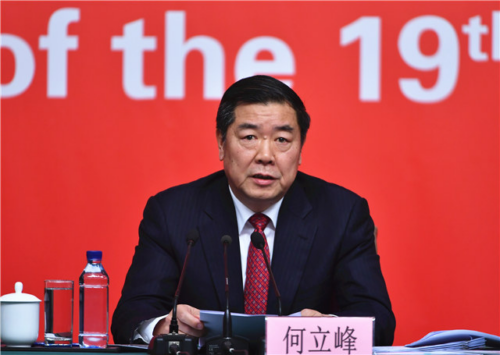Gray rhinos and risk awareness in China and the U.S. — Q&A with Michele Wucker
Why did the concept of the gray rhino — a big, obvious threat some people nonetheless ignore or neglect — so capture the imagination of Chinese officials and journalists and businesspeople? I spoke to the inventor of the concept to find out.

A front-page People’s Daily editorial in July 2017 warned that “preventing and resolving financial risks” was a key goal of the government’s economic policy. The article mentioned two types of risks: “black swans” (黑天鹅 hēi tiān’é), which are risks that are completely unpredictable, and “gray rhinoceroses” (灰犀牛 huī xīniú), a term coined by writer, entrepreneur, and strategist Michele Wucker in a 2013 Davos speech and subsequent book.
Since then, the gray rhino concept has come into common use in China, particularly among government officials and in the business press. Xí Jìnpíng 习近平 himself, in his New Year’s video greeting of 2018, had a copy of The Gray Rhino on his bookshelf.
A few weeks ago, I had a Zoom chat with Wucker about gray rhinos, why officials and businesspeople in China are so drawn to the concept, and ways of preparing for our uncertain global future.
This is an abridged, lightly edited excerpt of the transcript of our chat. You can watch the whole conversation on YouTube here.
—Jeremy Goldkorn
Michele, what exactly is a gray rhino?
The gray rhino is a metaphor for the need to take a fresh look at big, obvious threats. Think about the big, scary thing charging at you. What are you going to do? Some people see the big, scary thing coming and do something about it. Other people get trampled, or get out of the way and let somebody else get trampled. Some actually harness the strength of it.
At the beginning, many Americans said, “What do you mean we don’t pay attention to obvious things? Why do we need a book about paying attention to obvious things?” And so, we emphasized the neglect part saying, yes, we actually do miss obvious things.
A lot of the Western press talk about gray rhinos as only the things that we neglect when there’s actually already a term for that, “the elephant in the room.” The gray rhino is something that only some people neglect. Those who don’t have a huge advantage.
Let’s talk about Western and Chinese media coverage of the gray rhino. Have you noticed differences between the way the concept is discussed?
Oh, my, that would be the understatement of… The book came out in the U.S. in 2016, in the middle of the election season, two weeks before the New York primary. There was a lot of pushback.
In China, the book came out in early 2017 and within three weeks it had gone into its third printing. Later in the summer when the front-page editorial came out in the People’s Daily, I got emails from all over the place.
The New York Times got the definition right from the beginning but used these big, aggressive international companies as examples — Wanda, Anbang, Fosun, and HNA. They decided that gray rhinos were synonymous with these companies: big, politically connected, aggressively borrowing, expanding internationally.
I get a lot of requests from Chinese reporters to talk about all sorts of things but they’ve never once asked me about these companies. So, that’s one big difference.
When Chinese government officials talk about gray rhinos, what should observers like me, and businesspeople, and bankers take away from it?
If the Chinese are talking about something as a gray rhino, they see it as something that is very important that needs to be dealt with. They don’t want to get trampled. They want to deal with it.
If you look at that People’s Daily editorial from July 2017, they talked about financial risks, which include shadow banking, and new wealth management products. Some of those were “lower risk, higher return.” It wasn’t the most accurate advertising ever. The same day [the editorial was published], small cap and tech stocks in China dropped by roughly 5%.
Just a couple of weeks later, Evergrande repeated its pledge to reduce its borrowing. Then, we started to see a lot of very surgical financial risk policies, particularly around mortgage requirements, things like that.
The next spring, we saw a lot of peer-to-peer lending platforms go under. After years of effort to address the real estate crisis, Evergrande and others started teetering about a year ago. Beijing was looking at the side effects, how to manage it bit by bit.
In fall of 2017, there was a big urban fire and urban safety was talked up as a gray rhino. Also in fall 2017, China’s top regulator mentioned real estate as a big gray rhino. But in that same speech, he also talked about financial regulation, fintech, and the internet. That was when policy changes and crackdowns on financial internet companies got into gear.
So basically when the government talks about gray rhinos, everybody should be very careful because, if the gray rhino itself doesn’t run you over and stampede you into the ground, the Chinese Communist Party probably will.
How about the Chinese media and high-level Chinese audiences that you’ve interacted with? You go to China and speak to a lot of people, so what are the typical questions you get from the media and audiences?
I’m impressed by the Chinese media. I get really thoughtful questions on all sorts of topics, including some of the first about digital data. There was a fight between a hardware provider and a platform provider over who owned the data and a lot of questions were asked about financial risk, obviously.
There are a lot of questions about the U.S. There’s a huge disconnect between the way people talk about financial risk in China and in the U.S. I talk a lot about the speculative versus the real economy. Reporters in China ask me about that.
I did a presentation for a C40 financial group with top Chinese policy-makers. And we had a very detailed conversation about financial risk policies, about asset bubbles, and about how to deal with them. People are very aware that it’s not easy to recognize when an asset bubble is about to pop. They realize that it’s not easy to try to slow its growth, which is what China has been doing to prevent a much bigger crisis down the road.
What are the top gray rhinos we should be looking out for in the global economy?
Gray rhinos look different from every perspective, but three interrelated issues have been going on for a while. One is financial fragility, which includes these asset bubbles. Then there’s climate change, and its potential impacts on the financial system and on everything else. And, third is inequality, which results from some of these financial policies, and is closely related to climate change: The people who caused the least are suffering the most.
In the short-term, I’m very concerned about the political and social situation in the United States and its impact on the U.S. economy, and in turn, on the global economy, and in turn on geopolitical tensions. The domino effect that the U.S. situation can create is at the center of my mind.
You wrote an article for the Financial Times on the U.S. being China’s biggest financial risk. I assume that’s connected to what you are talking about?
I wrote that a few years ago after several trips to China, where people were much more concerned with financial risk, and the consequences of a highly-financialized economy sucking money away from the real economy. If companies or investors can make a quick buck in secondary markets — stock markets and financial markets that are being inflated by central banks — they’re going to put their money there instead of into real businesses that create jobs but are probably going to grow more slowly. That’s a big problem.
Shortly after I wrote that piece, senior officials in Beijing were quoted in the Wall Street Journal as saying that the U.S., and in particular, recent tax cuts, was a big gray rhino for China. They started adjusting interest rates and were really concerned about the impact of the changes in the U.S. economy on China. in huge contrast to the United States where we can’t seem to get things done.
It seems to me the nature of Xi Jinping’s rule could be thought of as a gray rhino. There’s clearly an inability of all the people around Xi Jinping to tell him bad news or say no.
Do you see risks in China? I agree that there appears to be a much steadier hand on the financial planning tiller than there is in the United States, but when it comes to politics, I don’t know, maybe gray rhino is not the right word.
I think that there are lots of challenges. You could think about it as a crash of gray rhinos. I love the English language. That’s the word for a group of rhinos. I think that the political challenges in China and the U.S. are quite different. Our challenges are getting anything done and avoiding electing crazy people to public office. Our political gray rhinos are really very serious.
In China, I don’t have any particular insights into Xi Jinping’s inner circle and things like that, but from the way they’ve embraced the gray rhino concept, a lot of things get addressed.
Your most recent book is called You Are What You Risk: The New Art and Science of Navigating an Uncertain World.
They’ve actually marketed it as Gray Rhino 2 in China…
A sequel?
And it is very much a sequel. It came out of the conversations in China and elsewhere. And one of the things people are saying is “Oh, Chinese people are very risk averse,” a word I hate. The a-word, I’ve started to call it.
The whole question of “risk averse” is a problem. Somebody may take fewer risks, all things being the same, but there’s rarely a circumstance where all things are the same.
In the book, there’s some research with college students, which is a limited circle, but there were some Chinese and some American subjects in the study. They were given a financial risk question and all the participants, ahead of time, said that they thought that the Americans would take the riskier choice. As it turned out, they made very, very similar choices.
Chinese people are more risk aware. They recognize things faster and they pay more attention. As you perceive the risk and do something about it, the risk itself changes. We’re seeing a lot of that in China right now. They think about it and they’re more likely to act than Americans are. They perceived the so-called riskier option to be less risky than the Americans did.
In Beijing, I can’t count the number of times people have said, “Oh, my parents want to buy an apartment.” I tell them that it’s a bubble and way too expensive. And they say, “Oh, no, the government won’t let anything bad happen.” I think the sense of personal agency and collective agency is really important. People would rather be wrong with everybody else than right alone.
In China, people expect the government to make decisions. It can make decisions fast, and it can do things that this crazy dysfunctional democracy in the United States can’t do.






